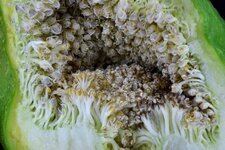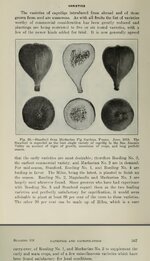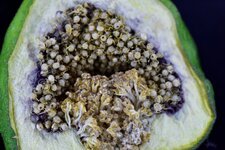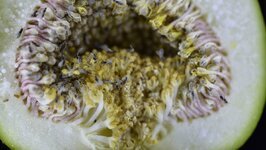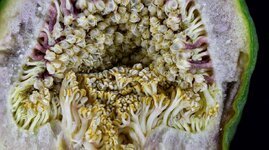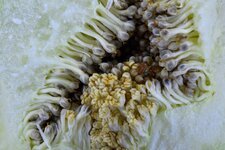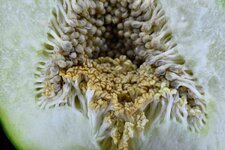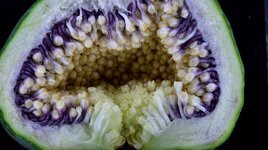You are using an out of date browser. It may not display this or other websites correctly.
You should upgrade or use an alternative browser.
You should upgrade or use an alternative browser.
Should I grow a Caprifig?
- Thread starter GoodFriendMike
- Start date
Full sun is certainly best for the tree's growth, only their leaves need to shade the figs.
That would be what I would do also, and if there is room, possibly 6, and just retain the ones that do better for you....or keep them all?
With Condit's work, I believe his 1955 Fig Varieties ...is possibly a better one to look at, Caprifigs, and in fact all figs are listed by internal and external colour, it gives a better idea of everything, to make a better decision. I have included a digital copy below.
Thank you for your continued support!
Going through Condit's 1930 publication, I was able to extract some useful information (attached). Next is working through the 1955 publication you kindly shared.
A first follow-up question that pops up: Are these "old" varieties (Markarian #2, Roeding #1, #3, and #4, Milco, and Stanford) still available through "our community"?
IF (!) I can get my hands on 2 of each early, mid and late varieties (6 total), I'd try to graft two complementary trees, each containing one of each and one tree containing Milco, the other Stanford, as these both "carry-over" (support the wasp year-round). However... depending on what I find in the 1955 publication, my strategy will probably improve further...
Attachments
WOWWWW! These are AMAZING photos!These are local trees here, but if I was you, I would be looking for at least 2 that looked like these, big size, plenty of pollen and wasps, and totally different colour internally.
View attachment 8162View attachment 8163
Currently I have SR-35 (recommended by @GoodFriendMike and a kind gift of @Fig Gazer ) and the locally "procured" Home Depot caprifig [to be characterized, but the original tree looks VERY promising; loaded with big figs all year around], and Oakleigh #1 [Emma Prusch Farm Pak] growing. I'll see how these might fit into the scheme...
Last edited:
Rob
Well-known member
You are very welcome!Thank you for your continued support!
I think the 1955 paper will give you much more, and detailed information.Going through Condit's 1930 publication, I was able to extract some useful information (attached). Next is working through the 1955 publication you kindly shared.
I think you should be able to source most , if not all of the ones you noted, but I have a feeling Roeding's #1 and #4 were not great.A first follow-up question that pops up: Are these "old" varieties (Markarian #2, Roeding #1, #3, and #4, Milco, and Stanford) still available through "our community"?
Take your time, in the end it will be worth it.IF (!) I can get my hands on 2 of each early, mid and late varieties (6 total), I'd try to graft two complementary trees, each containing one of each and one tree containing Milco, the other Stanford, as these both "carry-over" (support the wasp year-round). However... depending on what I find in the 1955 publication, my strategy will probably improve further...
GoodFriendMike
Moderator
The Roeding's, Stanford, and Milco are still around. Have a few of those myself.Thank you for your continued support!
Going through Condit's 1930 publication, I was able to extract some useful information (attached). Next is working through the 1955 publication you kindly shared.
A first follow-up question that pops up: Are these "old" varieties (Markarian #2, Roeding #1, #3, and #4, Milco, and Stanford) still available through "our community"?
IF (!) I can get my hands on 2 of each early, mid and late varieties (6 total), I'd try to graft two complementary trees, each containing one of each and one tree containing Milco, the other Stanford, as these both "carry-over" (support the wasp year-round). However... depending on what I find in the 1955 publication, my strategy will probably improve further...
Rob
Well-known member
Schoenie said:
IF (!) I can get my hands on 2 of each early, mid and late varieties (6 total), I'd try to graft two complementary trees, each containing one of each and one tree containing Milco, the other Stanford, as these both "carry-over" (support the wasp year-round). However... depending on what I find in the 1955 publication, my strategy will probably improve further...
Just thinking more on this, since you are in California, and I understand that California is a big area, but if you look around you, or look at the picture below, or look at this link, there is a good chance you may find exactly what you are looking for close to you. There has to be thousands of Caprifig trees not added to the list so far, so this map is certainly not showing all trees. In my area in Australia, I know of about 40 within a 30 minute drive from me. https://www.google.com/maps/d/edit?mid=15aAp3no1ZoS2Jt78t6l771N9CylY4Mc&usp=drive_link

IF (!) I can get my hands on 2 of each early, mid and late varieties (6 total), I'd try to graft two complementary trees, each containing one of each and one tree containing Milco, the other Stanford, as these both "carry-over" (support the wasp year-round). However... depending on what I find in the 1955 publication, my strategy will probably improve further...
Just thinking more on this, since you are in California, and I understand that California is a big area, but if you look around you, or look at the picture below, or look at this link, there is a good chance you may find exactly what you are looking for close to you. There has to be thousands of Caprifig trees not added to the list so far, so this map is certainly not showing all trees. In my area in Australia, I know of about 40 within a 30 minute drive from me. https://www.google.com/maps/d/edit?mid=15aAp3no1ZoS2Jt78t6l771N9CylY4Mc&usp=drive_link

Ah.... now you said it!The Roeding's, Stanford, and Milco are still around. Have a few of those myself.
My understanding (from an old post by @Fig Gazer) is that SR-35's profichi ripens (very) EARLY, right?
GoodFriendMike
Moderator
He could answer that question better than me. I did ripen some early when I had the wasp.Ah.... now you said it!Come pruning time next year, I'll probably be bugging you!
My understanding (from an old post by @Fig Gazer) is that SR-35's profichi ripens (very) EARLY, right?
Good Capri. But needs the wasp.
Thank you for the suggestion Rob. You are totally right of course! BTW: I have used this (your?) map many times to figure out a possible strategy (if needed at all) of "harvesting" some wasp-containing figs to bring into my garden and get the party started.Schoenie said:
IF (!) I can get my hands on 2 of each early, mid and late varieties (6 total), I'd try to graft two complementary trees, each containing one of each and one tree containing Milco, the other Stanford, as these both "carry-over" (support the wasp year-round). However... depending on what I find in the 1955 publication, my strategy will probably improve further...
Just thinking more on this, since you are in California, and I understand that California is a big area, but if you look around you, or look at the picture below, or look at this link, there is a good chance you may find exactly what you are looking for close to you. There has to be thousands of Caprifig trees not added to the list so far, so this map is certainly not showing all trees. In my area in Australia, I know of about 40 within a 30 minute drive from me. https://www.google.com/maps/d/edit?mid=15aAp3no1ZoS2Jt78t6l771N9CylY4Mc&usp=drive_link
View attachment 8231
The problem, however, is that I have no idea whatsoever which of these trees are early or late "profichi bloomers" (In all honesty, I totally lack the knowledge on how to establish that...). With all the in-depth work done by Eisen, Condit, and the more recent fig-growing community, it seems obvious for me to benefit from the existing information and go from there. I don't know how important it is, in the end, to have an early, mid, and late variety (having the "carry-over" in place seems more critical), but I figured" why not aim for that?
Rob
Well-known member
The only way to establish ripening times on all fig trees is to constantly revisit these trees and document it as I have done here, but it takes time. I need to update some info now, but it is still pretty accurate.Thank you for the suggestion Rob. You are totally right of course! BTW: I have used this (your?) map many times to figure out a possible strategy (if needed at all) of "harvesting" some wasp-containing figs to bring into my garden and get the party started.
The problem, however, is that I have no idea whatsoever which of these trees are early or late "profichi bloomers" (In all honesty, I totally lack the knowledge on how to establish that...). With all the in-depth work done by Eisen, Condit, and the more recent fig-growing community, it seems obvious for me to benefit from the existing information and go from there. I don't know how important it is, in the end, to have an early, mid, and late variety (having the "carry-over" in place seems more critical), but I figured" why not aim for that?
Caprifigs early to later.
Wow Rob! That's an impressive body of work that you've compiled!The only way to establish ripening times on all fig trees is to constantly revisit these trees and document it as I have done here, but it takes time. I need to update some info now, but it is still pretty accurate.
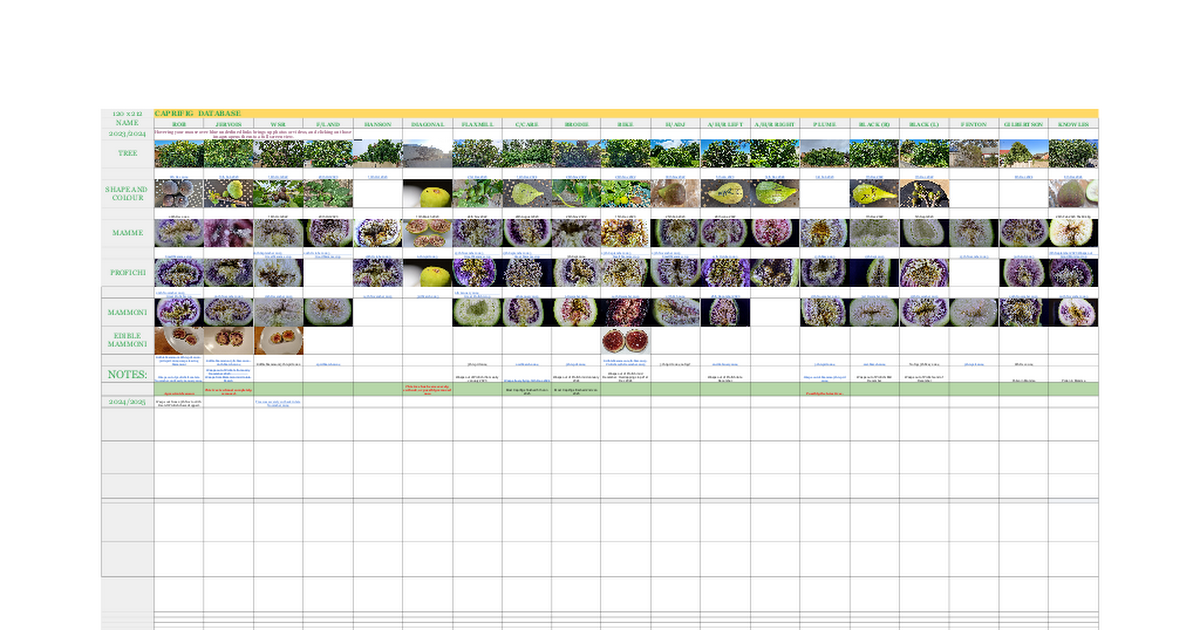
Caprifigs early to later.
docs.google.com
I do have access to a few wild caprifigs: how exactly do I distinguish between ripe and not-yet / almost ripe profichi crop? In other words: what is it that I'm looking for in order to say "This one is ripe!"? Slicing a few figs and seeing "powdery" pollen that can be lifted off?
Thanks again for sharing mate; I really appreciate it!
TorontoJoe
Administrator
Schoenie said:
IF (!) I can get my hands on 2 of each early, mid and late varieties (6 total), I'd try to graft two complementary trees, each containing one of each and one tree containing Milco, the other Stanford, as these both "carry-over" (support the wasp year-round). However... depending on what I find in the 1955 publication, my strategy will probably improve further...
Just thinking more on this, since you are in California, and I understand that California is a big area, but if you look around you, or look at the picture below, or look at this link, there is a good chance you may find exactly what you are looking for close to you. There has to be thousands of Caprifig trees not added to the list so far, so this map is certainly not showing all trees. In my area in Australia, I know of about 40 within a 30 minute drive from me. https://www.google.com/maps/d/edit?mid=15aAp3no1ZoS2Jt78t6l771N9CylY4Mc&usp=drive_link
View attachment 8231
Phoenix?
Rob
Well-known member
Thank you, for some time I just had them all in separate folders, but it was far too hard to compare them quickly, but then it was obvious that all of the pictures in a smaller size didn't show what I needed, so I made links for most photos to enlarge them, and also links for videos of the trees and wasps etc.Wow Rob! That's an impressive body of work that you've compiled!You must have put in A LOT of effort. I also love the photos.
Yes, exactly, if the pollen is very visible like this picture it is mature, (here is 6 pictures in order, from immature male flowers and wasp galls, to mature pollen and most galls empty, wasps gone) and if there are wasps crawling around, pollen should already be mature. Here, all Caprifigs are firm when mature, unlike figs we eat that are saggy, and soft.I do have access to a few wild caprifigs: how exactly do I distinguish between ripe and not-yet / almost ripe profichi crop? In other words: what is it that I'm looking for in order to say "This one is ripe!"? Slicing a few figs and seeing "powdery" pollen that can be lifted off?
You are welcome.Thanks again for sharing mate; I really appreciate it!
Attachments
That's a very helpful visual guidance. Thank you for sharing!
I'll try to drive over to my most accessible caprifig tomorrow, pull off a few figs, and see if I can produce similar pictures for comparison...
Your photos are really nice. Almost like you made them with a low magnification microscope. I'll first see what I can do with my iPhone.
I can always switch to my tripod and DSLR camera if needed...
I'll try to drive over to my most accessible caprifig tomorrow, pull off a few figs, and see if I can produce similar pictures for comparison...
Your photos are really nice. Almost like you made them with a low magnification microscope. I'll first see what I can do with my iPhone.
I can always switch to my tripod and DSLR camera if needed...
Rob
Well-known member
That is a great idea, hands on experience is the way to go since you are in the right area, and with trees close.That's a very helpful visual guidance. Thank you for sharing!
I'll try to drive over to my most accessible caprifig tomorrow, pull off a few figs, and see if I can produce similar pictures for comparison...
With the pictures, I found that a good camera with a great lens was the answer, it just takes the guesswork out of it all, and pictures are very large and detailed, all about 24Mb. Then I can crop out what I want and reduce the size after, and still get clear pictures that everyone can see details in.Your photos are really nice. Almost like you made them with a low magnification microscope. I'll first see what I can do with my iPhone.
I can always switch to my tripod and DSLR camera if needed...
OK my fig friends, here's the first "wild" tree, found behind the local central library.(there are actually 3 trees there).
These trees might well be seedlings as they do not appear on the explanatory panel nor the general landscaping scheme.
It started leafing out at the end of March, and is now doing well (only a bit of FMV it seems), with big, shiny leaves.
I found a single (!) fig on last year's wood, and sliced that open...
Looks like a caprifig to me, and... like profichi crop, although I'm not 100% sure).
I believe I see two types of flowers, but not much pollen...
Please educate me!
These trees might well be seedlings as they do not appear on the explanatory panel nor the general landscaping scheme.
It started leafing out at the end of March, and is now doing well (only a bit of FMV it seems), with big, shiny leaves.
I found a single (!) fig on last year's wood, and sliced that open...
Looks like a caprifig to me, and... like profichi crop, although I'm not 100% sure).
I believe I see two types of flowers, but not much pollen...
Please educate me!
Attachments
-
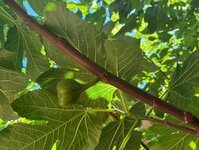 Tree #2, ''lonely'' fig.JPG268.9 KB · Views: 4
Tree #2, ''lonely'' fig.JPG268.9 KB · Views: 4 -
 Tree #2, Leaved appearance.JPG405.2 KB · Views: 11
Tree #2, Leaved appearance.JPG405.2 KB · Views: 11 -
 Tree #2, cut fig.JPG307.6 KB · Views: 14
Tree #2, cut fig.JPG307.6 KB · Views: 14 -
 Tree #2, cut fig zoom 3.JPG148.9 KB · Views: 13
Tree #2, cut fig zoom 3.JPG148.9 KB · Views: 13 -
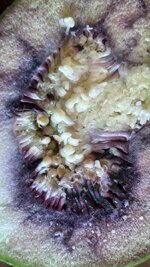 Tree #2, cut fig zoom 2.JPG203.5 KB · Views: 10
Tree #2, cut fig zoom 2.JPG203.5 KB · Views: 10 -
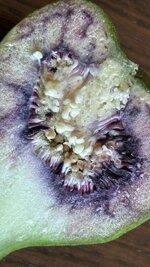 Tree #2, cut fig zoom 1.JPG224.2 KB · Views: 11
Tree #2, cut fig zoom 1.JPG224.2 KB · Views: 11 -
 Tree #2, BIG, shiny leaves.JPG304.1 KB · Views: 12
Tree #2, BIG, shiny leaves.JPG304.1 KB · Views: 12 -
 Tree #2, March 22, 2025.JPG318.5 KB · Views: 8
Tree #2, March 22, 2025.JPG318.5 KB · Views: 8
GoodFriendMike
Moderator
Wow. Really Beautiful photo's. Capri have both male and female flowers. Figs are not ripe enough for pollenOK my fig friends, here's the first "wild" tree, found behind the local central library.(there are actually 3 trees there).
These trees might well be seedlings as they do not appear on the explanatory panel nor the general landscaping scheme.
It started leafing out at the end of March, and is now doing well (only a bit of FMV it seems), with big, shiny leaves.
I found a single (!) fig on last year's wood, and sliced that open...
Looks like a caprifig to me, and... like profichi crop, although I'm not 100% sure).
I believe I see two types of flowers, but not much pollen...
Please educate me!
TorontoJoe
Administrator
OK my fig friends, here's the first "wild" tree, found behind the local central library.(there are actually 3 trees there).
These trees might well be seedlings as they do not appear on the explanatory panel nor the general landscaping scheme.
It started leafing out at the end of March, and is now doing well (only a bit of FMV it seems), with big, shiny leaves.
I found a single (!) fig on last year's wood, and sliced that open...
Looks like a caprifig to me, and... like profichi crop, although I'm not 100% sure).
I believe I see two types of flowers, but not much pollen...
Please educate me!
Very good stuff! Loving the purple colours!
Rob
Well-known member
Yes, as Mike mentioned, this Caprifig is still a few weeks at least from being mature, so certainly not an early one. Since it is on old wood, it would have to be a Profichi Caprifig. It's also not good that now there are no other figs on this tree, unless of course other Caprifig trees are close by, since there is no way for the colony to survive.OK my fig friends, here's the first "wild" tree, found behind the local central library.(there are actually 3 trees there).
These trees might well be seedlings as they do not appear on the explanatory panel nor the general landscaping scheme.
It started leafing out at the end of March, and is now doing well (only a bit of FMV it seems), with big, shiny leaves.
I found a single (!) fig on last year's wood, and sliced that open...
Looks like a caprifig to me, and... like profichi crop, although I'm not 100% sure).
I believe I see two types of flowers, but not much pollen...
Please educate me!

